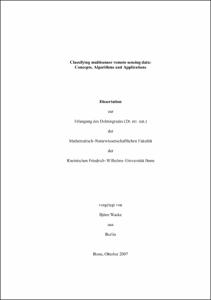Classifying multisensor remote sensing dataConcepts, Algorithms and Applications

Classifying multisensor remote sensing data
Concepts, Algorithms and Applications

| dc.contributor.advisor | Menz, Gunter | |
| dc.contributor.author | Waske, Björn | |
| dc.date.accessioned | 2020-04-10T20:42:19Z | |
| dc.date.available | 2020-04-10T20:42:19Z | |
| dc.date.issued | 2007 | |
| dc.identifier.uri | https://hdl.handle.net/20.500.11811/3197 | |
| dc.description.abstract | Today, a large quantity of the Earth’s land surface has been affected by human induced land cover changes. Detailed knowledge of the land cover is elementary for several decision support and monitoring systems. Earth-observation (EO) systems have the potential to frequently provide information on land cover. Thus many land cover classifications are performed based on remotely sensed EO data. In this context, it has been shown that the performance of remote sensing applications is further improved by multisensor data sets, such as combinations of synthetic aperture radar (SAR) and multispectral imagery. The two systems operate in different wavelength domains and therefore provide different yet complementary information on land cover. Considering the increase in revisit times and better spatial resolutions of recent and upcoming systems like TerraSAR-X (11 days; up to1 m), Radarsat-2 (24 days; up to 3 m), or RapidEye constellation (up to 1 day; 5 m), multisensor approaches become even more promising. However, these data sets with high spatial and temporal resolution might become very large and complex. Commonly used statistical pattern recognition methods are usually not appropriate for the classification of multisensor data sets. Hence, one of the greatest challenges in remote sensing might be the development of adequate concepts for classifying multisensor imagery. The presented study aims at an adequate classification of multisensor data sets, including SAR data and multispectral images. Different conventional classifiers and recent developments are used, such as support vector machines (SVM) and random forests (RF), which are well known in the field of machine learning and pattern recognition. Furthermore, the impact of image segmentation on the classification accuracy is investigated and the value of a multilevel concept is discussed. To increase the performance of the algorithms in terms of classification accuracy, the concept of SVM is modified and combined with RF for optimized decision making. The results clearly demonstrate that the use of multisensor imagery is worthwhile. Irrespective of the classification method used, classification accuracies increase by combining SAR and multispectral imagery. Nevertheless, SVM and RF are more adequate for classifying multisensor data sets and significantly outperform conventional classifier algorithms in terms of accuracy. The finally introduced multisensor-multilevel classification strategy, which is based on the sequential use of SVM and RF, outperforms all other approaches. The proposed concept achieves an accuracy of 84.9%. This is significantly higher than all single-source results and also better than those achieved on any other combination of data. Both aspects, i.e. the fusion of SAR and multispectral data as well as the integration of multiple segmentation scales, improve the results. Contrary to the high accuracy value by the proposed concept, the pixel-based classification on single-source data sets achieves a maximal accuracy of 65% (SAR) and 69.8% (multispectral) respectively. The findings and good performance of the presented strategy are underlined by the successful application of the approach to data sets from a second year. Based on the results from this work it can be concluded that the suggested strategy is particularly interesting with regard to recent and future satellite missions. | |
| dc.language.iso | eng | |
| dc.rights | In Copyright | |
| dc.rights.uri | http://rightsstatements.org/vocab/InC/1.0/ | |
| dc.subject | Fernerkundung | |
| dc.subject | Klassifikation | |
| dc.subject | multispektral | |
| dc.subject | SAR | |
| dc.subject | multisensoral | |
| dc.subject | multitemporal | |
| dc.subject | Support Vector Machines | |
| dc.subject | remote sensing | |
| dc.subject | classification | |
| dc.subject | multispectral | |
| dc.subject | multisensor | |
| dc.subject.ddc | 500 Naturwissenschaften | |
| dc.subject.ddc | 550 Geowissenschaften | |
| dc.title | Classifying multisensor remote sensing data | |
| dc.title.alternative | Concepts, Algorithms and Applications | |
| dc.type | Dissertation oder Habilitation | |
| dc.publisher.name | Universitäts- und Landesbibliothek Bonn | |
| dc.publisher.location | Bonn | |
| dc.rights.accessRights | openAccess | |
| dc.identifier.urn | https://nbn-resolving.org/urn:nbn:de:hbz:5N-12854 | |
| ulbbn.pubtype | Erstveröffentlichung | |
| ulbbnediss.affiliation.name | Rheinische Friedrich-Wilhelms-Universität Bonn | |
| ulbbnediss.affiliation.location | Bonn | |
| ulbbnediss.thesis.level | Dissertation | |
| ulbbnediss.dissID | 1285 | |
| ulbbnediss.date.accepted | 14.12.2007 | |
| ulbbnediss.fakultaet | Mathematisch-Naturwissenschaftliche Fakultät | |
| dc.contributor.coReferee | Schmidtlein, Sebastian |
Dateien zu dieser Ressource
Das Dokument erscheint in:
-
E-Dissertationen (4089)




